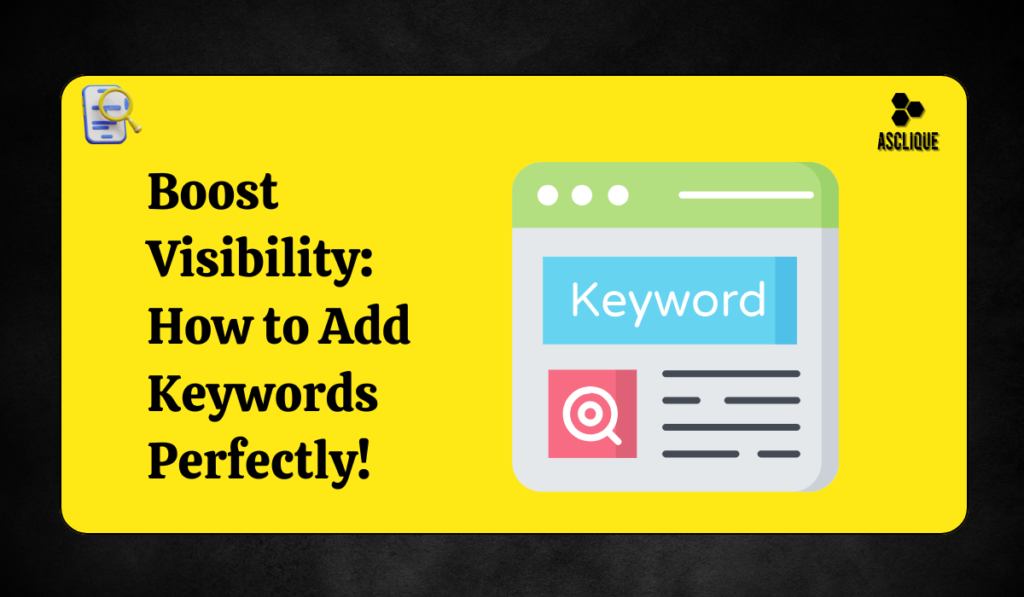Mastering how to put keywords on your site helps you increase visibility as well as drive targeted visitors to your website. When a website is keyword optimized, the content ranks in high positions in search engines that help connect you to interested people who are in turn searching for information products, or services you will provide. Here we would elaborate on every step necessary when adding keywords to your site that feel natural and is able to provide value between your audience and search engine algorithms.
Why do you need to learn how to add keywords to your website?
This means it’s not just looking for the website but the right search for the company. Now, since 68 percent of all online experiences started from a search engine, you want to know how to position those keywords on the website – that is, get the difference in reaching your target audience. You’re in great shape for rank-raising, organic traffic expansion, and even bringing in authority into your niche if your contents align with real search intent.
Step I: Learn and Select the Best Keyword

Before you begin, let’s learn how you can add keywords to a website. First, research the right keywords. Here’s how to pick an effective keyword: finding matched user intent and drive-traffic terms.
Carry out in-depth keyword research
- To identify the perfect words, get tools like Google Keyword Planner, Ahrefs, or SEMrush. These tools will show you search volume, competition and related keywords- help you figure out which terms would be handy.
-
Consider the Competition
- By reviewing your competition’s content, you can also see what keywords your rivals use. It can develop an opening in your strategy so you can optimize better.
User Intent
- The most important thing to learn about adding keywords to your website is user intent. Consider whether the users are looking for information, a specific product, or ready to make a purchase. Matching your keywords with this intent makes your content more relevant and valuable.
- Tip: Long-tail keyword studies demonstrate that they generate 70 percent of search traffic and thus become one of the most excellent words to apply on your niched targeting process when including keywords on your website.
Step II: Strategically Place Keywords Throughout Your Website
Adding keywords to your website is not just having a list of words. You should strategically place keywords so that your content can be search-engine and user-friendly. Here’s where to put them:
Title Tags
- Title tags are one of the most crucial SEO elements. They show up as the link you can click on when viewing the search results, so make sure you put your main keyword in the title. For example, if you are optimizing a blog, the title would be “How to Add Keywords to Your Website for SEO Success”.
Meta Descriptions
- Meta descriptions do not directly influence rankings, but they can influence click-through rates. Add your main keyword, such as “how to add keywords to your website,” and write a great description that will make users want to click.
Headers and Subheadings
- Headers (H1, H2, H3) are used to break up your content, making it easier for users and search engines to understand. Keywords in headers can help reiterate what your page is about.
- For instance, in case you are to provide a how-to guide on adding keywords to your website, then you may use H2 headers such as “Why Learning How to Add Keywords to Your Website is Important” or “Step-by-Step Guide on How to Add Keywords to Your Website.”.
Body Text
- Use the body of your content naturally. Keyword density should not be more than 1-2%. For example, if you are describing how to add keywords in your website, use terms such as “adding keywords to your site” or “optimizing keywords for your website.”
Image Alt Text
- Google cannot “see” pictures; therefore, using an alt text with keywords, for example, “how to add keywords to your website”, will help the search engine understand what is there on the image. Apart from improving SEO, this makes the site more accessible.
URLs
- This helps in improving SEO and contains keywords in the URL. Keep the URLs as short as possible, also to the point, but at the same time relevant for content. For example instead of www.example.com/page12345, use www.example.com/how-to-add-keywords-to-your-website.
Step III: Use Long-Tail Keywords
Long-tail keywords are usually highly specific and tend to bring very targeted traffic. So, when deciding how to put keywords on your website, remember that long-tail phrases are less competitive and tend to convert better because they are more targeted to specific search intent.
- Example: Instead of the broad keyword “SEO tips,” try “how to add keywords to your website for SEO.” This phrase is more specific and draws in users looking specifically to learn about where to place keywords.
Stat to Remember: Websites targeting long-tail keywords convert 2.5x better than those using more general terms.
Step IV: Use Internal Links with Keyword-Rich Anchor Text
- Adding internal links is part of learning how to add keywords to your website. In this case, using a keyword as anchor text while linking between pages helps make search engines understand the subjects of linked pages, and thus increases the relevance of them.
- For example, instead of the generic anchor text “click here,” use something like “learn how to add keywords to your website.” This method will assist with SEO as well as tell a user what to expect when they click.
Step V: Quality Content Over Keyword Quantity
It should carry quality content with adding a keyword. Google favors any valuable content, which generally means informative content rather than keyword-based pages with virtually no content to speak of. Here’s how to balance keyword usage with a quality content:
- Clearly answer questions through keywords: Employ the keywords to answer very common questions your target audience is likely asking. In an example, use the words “how to add keywords to your website,” thereby, letting your webpage be sufficiently relevant while answering their inquiries directly.
- Freshening Your Pages: Make more frequent content updates, particularly to your trend-related pages or your best practice pages. Frequently updated sites on their contents have 126% increases on organic traffic against sites without doing so.
Pro Tip: Humans and search engines like freshness. It helps you to stay relevant, putting in keywords naturally.
Step VI: Track and Adjust Your Keyword Strategy
SEO is an ongoing thing and knowing how to add the keyword to your website revolves around adaptation to data, hence, tracking and adapting to it is the process as follows.
- Use Google Analytics and Search Console: As you get the insights about which of your keywords drive traffic it’s easier to understand and find out how to add the keywords on your website.
- Track Keyword Rankings: By using Ahrefs or SEMrush, you find where your keywords rank and change course. If you have a keyword that’s not really ranking well, then reposition that keyword or attach relevant terms for better outreach.
Rapid Stat: Websites that optimize content using keywords will see a 53% increase in organic traffic.
Step 7: Optimize for Voice Search
- With voice search, having keywords in your website also comes with a new meaning-to make it voice-friendly. A voice search keyword is mostly a question-based word and often used in phrases as questions. To fit the bill, add the content including the question-based keywords. “How do I add keywords to your website?” Answer the question as it appears.
Also read: https://www.asclique.com/blog/how-to-choose-the-perfect-keywords-for-your-ecommerce-brand/
Conclusion: Adding Keywords to Your Website
This way, mastering the method of adding keywords on the website can drive in more traffic, improve ranks, and create a better user experience. It is to be focused upon finding the correct keywords, placing them appropriately, and regularly updating the content to maintain the relevancy in search engines as well as creating a meaningful value for users. Keywords are added in such a manner that it goes naturally in line with user intent and does not degrade in terms of quality.
FAQ’s
How do I select keywords for my website?
Aim to review and update keywords at least every quarter or semi-annually. Regular updates ensure your site stays aligned with search trends and user needs.
Can I use the same keywords on every page?
No, it’s best to use unique primary keywords for each page to avoid keyword cannibalization, which can lead to lower rankings.
How many keywords should you target per page?
Focus on one primary keyword and 2-3 secondary keywords. This keeps content natural and avoids keyword stuffing.
What is the ideal keyword density?
Aiming for a keyword density of 1-2% is usually effective. Use your primary keyword once or twice per 100 words.

